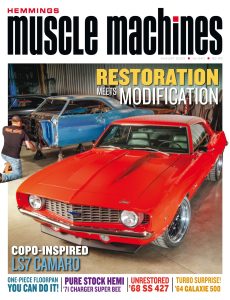
Hemmings Muscle Machines – August 2023
English | 78 pages | pdf | 77.13 MB
Muscle car fans tend to be hot rodders at heart, and an appreciation for speed and competition still burns within many of us.
Several years ago, I had the idea to build a car from the muscle era to use for autocrossing and maybe some road course events. The inspiration came from growing trends that saw classic muscle being set up for those types of competitions, something that was gaining steam rapidly. Performance driving that involved turning hadn’t been a priority for American cars of the ’60s and ’70s, save perhaps for Corvettes and certain Mustangs and Camaros, but interest in improving the handling of all muscle cars was on the rise in the late ’90s.
This trend picked up the term “Pro Touring” from one of its most visible developers, Mark Stielow, who was then a young engineer at General Motors. He’d built a ’69 Camaro to go head-to-head with newer, more sophisticated machinery in Car and Driver magazine’s One Lap of America event and went on to build a series of increasingly capable first-gen Camaros, often utilizing performance technology and hardware from the whatever the latest Corvettes and Camaros were highlighting. Stielow didn’t build the Camaro on this month’s cover, but contributor Barry Kluczyk included some interview insights from him in his story, since the car was built in the same vein as some of Stielow’s own. That influence had spread back in the ’90s in part because Stielow had connected with then-editor of Hot Rod magazine (and occasional HMM contributor) Jeff Smith to feature the One Lap Camaro and its improvements.
That Camaro, and others that followed from Stielow, seemed to inspire a lot of classic muscle fans to consider doing similar things to their own cars, though for a time, many of the trend’s emulators appeared more interested in adhering to a master parts list rather than genuinely preparing their muscle cars for track use. Big brakes, trick suspension components, 16-, 17-, and then 18-inch wheel/tire combos, all featured as requisite items, along with some sort of overdrive transmission and of course, an infusion of power.
The spec sheets for those cars always looked impressive, but their actual capabilities were questionable since most had never turned a tire on anything but a showfield. That began to change when the Optima Ultimate Street Car Invitational was launched in 2008 immediately following that year’s SEMA show. This event was aimed squarely at Pro-Touring-style muscle cars (and trucks) and provided a venue to post numbers from an autocross course and a road course, while also requiring contestants to complete a road tour. The idea was to call out builders of SEMA show display vehicles to see if their creations could perform as claimed. It gained a lot of attention and turned into a series that’s still running today.
While these facets of the muscle world were developing, the “restomod” movement was also taking off. The term seemed to start in the vintage Mustang sect, referring to cars that appeared to be
essentially stock, but which had been upgraded for better road manners, performance, and comfort. It spread to other groups and evolved to point where it now covers a broad array of modified vehicles.
During the past several years, I’ve noticed this trend is even having an impact on some of the people who have been active in the muscle car restoration world for a long time. But rather than leading those people away from original spec projects, the restomod influence is being embraced as a sort of occasional alternative, one that encourages putting on lots of road miles— something high-level restorations rarely see today.
For some of those restoration veterans, a restomod is a fun diversion, waiting in the wings to be enjoyed more casually during breaks from work on highlevel factory-correct projects.
I think this merging of disciplines works in the pages of HMM as well. As much as we continue to marvel at factory rarities and highlight the quests taken to return some of them to absolute factory correctness, the desire to use performance cars for their intended purpose—and to make them better— remains a powerful force. Muscle car fans tend to be hot rodders at heart, and an appreciation for speed and competition still burns within many of us.
And so, the story on the ’69 Camaro featured on this month’s cover seemed a perfect way to highlight both restoration—an integral part of reviving 50-year-old classics no matter what their intended purpose—and the pursuit of performance modifi – cations. Let us know what you’ve been working on and what you want to do with it now that summer is finally here.
TERRY McGEAN [email protected] • Instagram @tmcgean
Download from:
One Response to “Hemmings Muscle Machines – August 2023”
Warning: call_user_func_array() expects parameter 1 to be a valid callback, function 'embed_bbcode ' not found or invalid function name in /home/magdownload/public_html/wp-includes/class-wp-hook.php on line 310